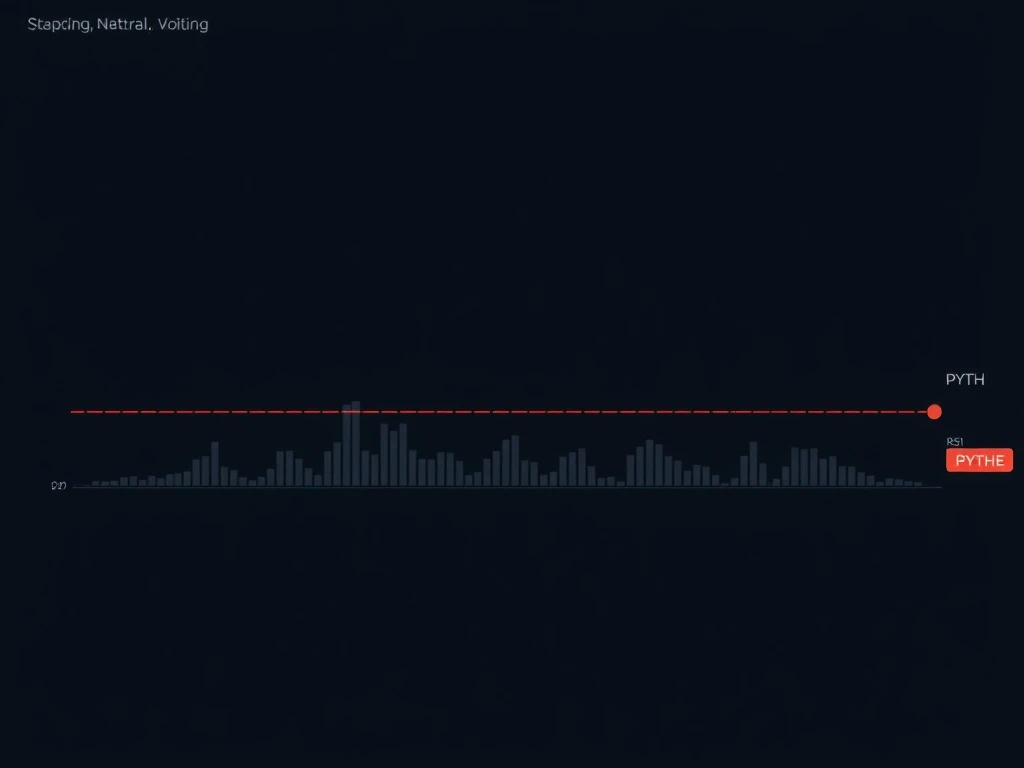PYTH Price: Navigating the Critical Consolidation Amid Low Volume

In the dynamic world of cryptocurrencies, market movements are often swift and decisive. However, sometimes, even prominent altcoins like PYTH find themselves in a state of quiet anticipation. Currently, the PYTH Price is undergoing a significant consolidation phase near the $0.1260 mark, a period characterized by reduced market activity and conflicting signals. This article delves into the nuances of PYTH’s current predicament, exploring the technical indicators, volume dynamics, and broader market metrics that define its uncertain path forward.
Understanding PYTH’s Current Price Consolidation
The term ‘consolidation’ in financial markets refers to a period where an asset’s price trades within a narrow range, indicating a balance between buying and selling pressures. For PYTH, this translates to a tight fluctuation between $0.1250 and $0.1272 on major exchanges like Binance. This tight range, coupled with declining trading activity, paints a picture of a market waiting for its next big move.
- Tight Range: PYTH has been largely confined to a $0.1250–$0.1272 range, suggesting neither bulls nor bears are currently strong enough to dictate a clear direction.
- Declining Volume: A critical observation is the significant drop in 24-hour trading volume, which has plummeted by 36.82% to approximately 9.3K. This reduction signals reduced market participation and a cautious sentiment among traders.
- Market Sentiment: Low volume during consolidation often indicates indecision. Traders are hesitant to commit capital, leading to a ‘wait and see’ approach.
Decoding the Technical Signals: RSI, MACD, and Key Levels
For traders and investors, technical indicators provide valuable insights into an asset’s momentum and potential future movements. For PYTH, these indicators are currently sending mixed signals, reinforcing the ongoing crypto consolidation.
The Relative Strength Index (RSI) stands at 47.56. The RSI is a momentum oscillator that measures the speed and change of price movements. A reading near 50, as seen with PYTH, typically indicates a balanced market, meaning it’s neither overbought (above 70) nor oversold (below 30). This neutral stance suggests that the asset is not experiencing extreme buying or selling pressure, contributing to the horizontal price action.
Similarly, the Moving Average Convergence Divergence (MACD) remains flat near the zero line. The MACD is a trend-following momentum indicator that shows the relationship between two moving averages of an asset’s price. A flat MACD near zero suggests a lack of clear directional bias or strong momentum. When the MACD line is close to the signal line and both are hovering around zero, it indicates that the short-term and long-term momentum are converging, signifying a period of low volatility and consolidation.
Crucial Support and Resistance Levels
Technical levels are proving pivotal in PYTH’s current price action:
- Resistance at $0.1272: This level has acted as a strong ceiling, with PYTH’s price repeatedly failing to break above it despite earlier attempts to build bullish momentum. Overcoming this resistance would be a key indicator of a potential upward trend.
- Support at $0.1250: This level is under close scrutiny. A breakdown below $0.1250 could trigger further declines, potentially retesting lower support zones.
- Broader Timeframe Analysis: On the 4-hour chart, PYTH has retested its breakout zone after a correction. Previously, a symmetrical triangle pattern propelled the token from $0.1000 to $0.1500. However, the current price action below the 9-period Exponential Moving Average (EMA) and 50-period Simple Moving Average (SMA) signals short-term bearish sentiment. Key support levels to watch for potential rebounds include $0.1200–$0.1220 and a more significant level at $0.1100.
Is Low Trading Volume a Red Flag for PYTH?
While consolidation itself isn’t inherently negative, the accompanying drop in trading volume is a significant factor. A 36.82% decline in 24-hour trading activity raises concerns about waning short-term interest. Low volume during consolidation can lead to:
- Increased Volatility on Breakouts: When volume is low, a relatively small amount of buying or selling pressure can trigger a significant price movement. This means any eventual breakout or breakdown from the current range could be sharp.
- Delayed Price Movements: A sustained period of low volume can delay significant price movements. Traders often wait for volume to pick up as a confirmation of a new trend. Without renewed interest, PYTH might remain tethered to its current range for an extended period.
- Liquidity Implications: While the volume-to-market cap ratio of 5.92% suggests relatively healthy liquidity for PYTH’s circulating market cap of $724.2 million, the recent volume decline indicates a decrease in immediate trading opportunities.
The market needs a catalyst – a surge in volume, a significant news event, or a broader market shift – to break out of this cautious stance. Until then, the low trading volume acts as a dampener on any sustained directional moves.
Beyond the Charts: PYTH’s Market Metrics and Supply Dynamics
Beyond the immediate technical picture, understanding PYTH’s fundamental market signals and supply dynamics provides crucial context. With a fully diluted valuation (FDV) of $1.25 billion and 5.74 billion out of a total supply of 10 billion tokens currently in circulation, the supply side of the equation adds another layer of complexity.
Token unlocks are a recurring theme in the crypto space, where previously locked tokens held by early investors, team members, or advisors are released into the circulating supply. While not explicitly detailed for PYTH in the immediate future, the existence of a large total supply with a significant portion still locked means that future token unlocks could potentially increase selling pressure. If a substantial number of tokens are released onto the market, it could dilute demand and put downward pressure on the price, especially if market demand doesn’t grow proportionally.
Conversely, a well-managed tokenomics schedule with gradual unlocks can ensure price stability and healthy ecosystem growth. Traders are therefore not only watching the technicals but also keeping an eye on any announcements regarding future supply releases.
The immediate levels traders are monitoring are $0.1215 as a critical immediate support and $0.1300 as the next significant resistance. These levels will likely determine the immediate direction of the consolidation, signaling whether bulls or bears gain the upper hand.
Navigating the Uncertainty: What’s Next for PYTH?
The current state of PYTH reflects a market in limbo, a classic case of crypto consolidation. The neutral RSI and flat MACD clearly suggest that traders are waiting for clearer signals before committing to significant positions. This creates a stalemate where neither buyers nor sellers are strong enough to force a decisive move, leading to a period of price stability.
What could break this stalemate? Several scenarios are possible:
- Breakout Above $0.1272: A sustained move above this resistance level, ideally accompanied by a significant increase in trading volume, would signal renewed bullish momentum. This could potentially lead to a retest of higher price targets, perhaps towards the $0.1300 or even $0.1500 levels seen previously.
- Breakdown Below $0.1250: Conversely, a decisive drop below the $0.1250 support, also with increased volume, would confirm bearish sentiment. This could trigger a retest of previous lows, potentially sending PYTH towards the $0.1200-$0.1220 zone or even $0.1100.
- External Market Shifts: Broader cryptocurrency market trends, such as a significant move in Bitcoin or Ethereum, can also influence PYTH’s trajectory, pulling it along with the general market sentiment.
- Catalytic News: Any significant news regarding the Pyth Network’s development, partnerships, or adoption could serve as a fundamental catalyst to break the consolidation.
For now, market participants are advised to exercise caution. The lack of directional bias in momentum indicators underscores the prevailing uncertainty about PYTH’s near-term trajectory. Patience is key, as the market awaits definitive signals.
Conclusion
PYTH’s current price consolidation near $0.1260 is a classic example of a market in limbo. The interplay of low trading volume, critical psychological levels, and technical neutrality creates a delicate balance. While the immediate support at $0.1250 has held, a breakdown could pave the way for a retest of previous lows, while a decisive breakout above $0.1272 might reignite bullish momentum. For now, PYTH remains a compelling case study in market indecision, with its price tethered to its current range as observers await clarity. The next significant move will likely be dictated by a return of volume or a decisive break of key technical levels, marking the next phase for this intriguing altcoin.
Frequently Asked Questions (FAQs)
Q1: What does PYTH’s current consolidation mean?
PYTH’s consolidation means its price is trading within a narrow range ($0.1250-$0.1272) without a clear trend. This indicates a balance between buying and selling pressure, with neither bulls nor bears currently dominating the market.
Q2: Why is low trading volume a concern for PYTH?
Low trading volume, as seen with PYTH’s 36.82% drop, suggests reduced market participation and waning short-term interest. While it can lead to sharper price movements when a trend emerges, it also implies that significant price action might be delayed until volume recovers, indicating a lack of strong conviction from traders.
Q3: What do the neutral RSI and flat MACD signals indicate for PYTH?
A neutral RSI (around 47.56) indicates that PYTH is neither overbought nor oversold, suggesting a balanced market. A flat MACD near zero means there’s no strong directional momentum. Both signals reinforce the idea of market indecision and a waiting period for clearer trends to emerge.
Q4: What are the key price levels to watch for PYTH?
Traders are closely monitoring the resistance level at $0.1272 and the immediate support at $0.1250. A breakout above resistance could signal an upward trend, while a breakdown below support could lead to further declines, with $0.1215 and $0.1100 as subsequent support levels.
Q5: How do PYTH’s supply dynamics affect its price?
PYTH has a total supply of 10 billion tokens, with 5.74 billion in circulation. While not an immediate concern, future token unlocks (when previously locked tokens enter circulation) could increase selling pressure if market demand doesn’t keep pace, potentially impacting the price.
Q6: What could trigger PYTH to break out of its consolidation?
PYTH could break out of its consolidation with renewed trading volume, a decisive move above $0.1272 or below $0.1250, significant news related to the Pyth Network, or a strong directional shift in the broader cryptocurrency market.









